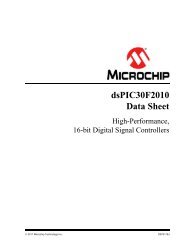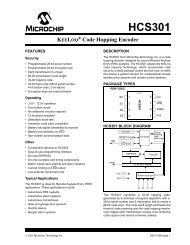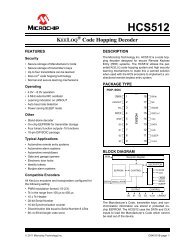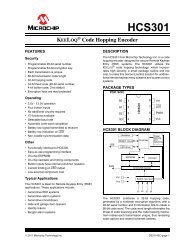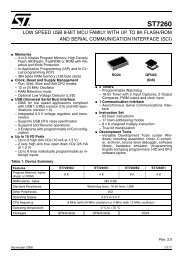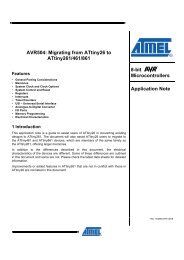LM2676 Data Sheet - TeenyChron
LM2676 Data Sheet - TeenyChron
LM2676 Data Sheet - TeenyChron
You also want an ePaper? Increase the reach of your titles
YUMPU automatically turns print PDFs into web optimized ePapers that Google loves.
<strong>LM2676</strong><br />
to reduce the closed loop unity gain bandwidth (to less than<br />
40KHz). When parallel combinations of capacitors are required<br />
it has been assumed that each capacitor is the exact<br />
same part type.<br />
The RMS current and working voltage (WV) ratings of the<br />
output capacitor are also important considerations. In a typical<br />
step-down switching regulator, the inductor ripple current<br />
(set to be no more than 30% of the maximum load current by<br />
the inductor selection) is the current that flows through the<br />
output capacitor. The capacitor RMS current rating must be<br />
greater than this ripple current. The voltage rating of the output<br />
capacitor should be greater than 1.3 times the maximum<br />
output voltage of the power supply. If operation of the system<br />
at elevated temperatures is required, the capacitor voltage<br />
rating may be de-rated to less than the nominal room temperature<br />
rating. Careful inspection of the manufacturer's<br />
specification for de-rating of working voltage with temperature<br />
is important.<br />
INPUT CAPACITOR<br />
Fast changing currents in high current switching regulators<br />
place a significant dynamic load on the unregulated power<br />
source. An input capacitor helps to provide additional current<br />
to the power supply as well as smooth out input voltage variations.<br />
Like the output capacitor, the key specifications for the input<br />
capacitor are RMS current rating and working voltage. The<br />
RMS current flowing through the input capacitor is equal to<br />
one-half of the maximum dc load current so the capacitor<br />
should be rated to handle this. Paralleling multiple capacitors<br />
proportionally increases the current rating of the total capacitance.<br />
The voltage rating should also be selected to be 1.3<br />
times the maximum input voltage. Depending on the unregulated<br />
input power source, under light load conditions the<br />
maximum input voltage could be significantly higher than normal<br />
operation and should be considered when selecting an<br />
input capacitor.<br />
The input capacitor should be placed very close to the input<br />
pin of the <strong>LM2676</strong>. Due to relative high current operation with<br />
fast transient changes, the series inductance of input connecting<br />
wires or PCB traces can create ringing signals at the<br />
input terminal which could possibly propagate to the output or<br />
other parts of the circuitry. It may be necessary in some designs<br />
to add a small valued (0.1μF to 0.47μF) ceramic type<br />
capacitor in parallel with the input capacitor to prevent or minimize<br />
any ringing.<br />
CATCH DIODE<br />
When the power switch in the <strong>LM2676</strong> turns OFF, the current<br />
through the inductor continues to flow. The path for this current<br />
is through the diode connected between the switch output<br />
and ground. This forward biased diode clamps the switch output<br />
to a voltage less than ground. This negative voltage must<br />
be greater than −1V so a low voltage drop (particularly at high<br />
current levels) Schottky diode is recommended. Total efficiency<br />
of the entire power supply is significantly impacted by<br />
the power lost in the output catch diode. The average current<br />
through the catch diode is dependent on the switch duty cycle<br />
(D) and is equal to the load current times (1-D). Use of a diode<br />
rated for much higher current than is required by the actual<br />
application helps to minimize the voltage drop and power loss<br />
in the diode.<br />
During the switch ON time the diode will be reversed biased<br />
by the input voltage. The reverse voltage rating of the diode<br />
should be at least 1.3 times greater than the maximum input<br />
voltage.<br />
BOOST CAPACITOR<br />
The boost capacitor creates a voltage used to overdrive the<br />
gate of the internal power MOSFET. This improves efficiency<br />
by minimizing the on resistance of the switch and associated<br />
power loss. For all applications it is recommended to use a<br />
0.01μF/50V ceramic capacitor.<br />
ADDITIONAL APPLICATON INFORMATION<br />
When the output voltage is greater than approximately 6V,<br />
and the duty cycle at minimum input voltage is greater than<br />
approximately 50%, the designer should exercise caution in<br />
selection of the output filter components. When an application<br />
designed to these specific operating conditions is subjected<br />
to a current limit fault condition, it may be possible to observe<br />
a large hysteresis in the current limit. This can affect the output<br />
voltage of the device until the load current is reduced<br />
sufficiently to allow the current limit protection circuit to reset<br />
itself.<br />
Under current limiting conditions, the LM267x is designed to<br />
respond in the following manner:<br />
1. At the moment when the inductor current reaches the<br />
current limit threshold, the ON-pulse is immediately<br />
terminated. This happens for any application condition.<br />
2. However, the current limit block is also designed to<br />
momentarily reduce the duty cycle to below 50% to avoid<br />
subharmonic oscillations, which could cause the inductor<br />
to saturate.<br />
3. Thereafter, once the inductor current falls below the<br />
current limit threshold, there is a small relaxation time<br />
during which the duty cycle progressively rises back<br />
above 50% to the value required to achieve regulation.<br />
If the output capacitance is sufficiently ‘large’, it may be possible<br />
that as the output tries to recover, the output capacitor<br />
charging current is large enough to repeatedly re-trigger the<br />
current limit circuit before the output has fully settled. This<br />
condition is exacerbated with higher output voltage settings<br />
because the energy requirement of the output capacitor<br />
varies as the square of the output voltage (½CV 2 ), thus requiring<br />
an increased charging current.<br />
A simple test to determine if this condition might exist for a<br />
suspect application is to apply a short circuit across the output<br />
of the converter, and then remove the shorted output condition.<br />
In an application with properly selected external components,<br />
the output will recover smoothly.<br />
Practical values of external components that have been experimentally<br />
found to work well under these specific operating<br />
conditions are C OUT = 47µF, L = 22µH. It should be noted that<br />
even with these components, for a device’s current limit of<br />
I CLIM , the maximum load current under which the possibility of<br />
the large current limit hysteresis can be minimized is I CLIM /2.<br />
For example, if the input is 24V and the set output voltage is<br />
18V, then for a desired maximum current of 1.5A, the current<br />
limit of the chosen switcher must be confirmed to be at least<br />
3A.<br />
SIMPLE DESIGN PROCEDURE<br />
Using the nomographs and tables in this data sheet (or use<br />
the available design software at http://www.national.com) a<br />
complete step-down regulator can be designed in a few simple<br />
steps.<br />
Step 1: Define the power supply operating conditions:<br />
Required output voltage<br />
Maximum DC input voltage<br />
Maximum output load current<br />
www.national.com 12






